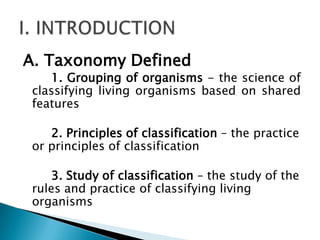
Menchie zoology
- 1. A. Taxonomy Defined 1. Grouping of organisms - the science of classifying living organisms based on shared features 2. Principles of classification – the practice or principles of classification 3. Study of classification – the study of the rules and practice of classifying living organisms
- 2. QUESTION: Would you also consider that taxonomy deals with IDENTIFICATION of living organisms? Why or why not?
- 3. Taxonomy involves: 1. Classification – ranking of groups of organisms in some hierarchical relationship - based on their similarities in their characteristics (genetic relationship, internal and external anatomy, physiology or evolutionary history) 2. Identification – separation of one group from other groups according to their unique characteristics
- 4. Identifying organisms based on their morphology, anatomy, physiology, cytology, biochemistry and geographic distribution WHAT ARE THE ROLES of TAXONOMISTS and SYSTEMATICISTS? To classify, identify and make a census of the unique characteristics of each species.
- 5. To reconstruct the evolutionary history of the present classified species based on morphology, anatomy, chemical composition, geographic distribution, breeding behavior, and chromosome number To determine which traits are advanced (derived in time from primitive traits) or primitive
- 6. To discover all species of animals. To reconstruct their evolutionary relationships. To classify animals according to their evoutionary relationships.
- 7. Unexplored areas, only an estimation could be done Continuous evolution process (diversification) Continuous extinction How about in local settings?
- 8. 300 BC Aristotle – used dichotomies or polar opposites Ex. Animals with blood and without blood (vertebrates and invertebrates) - wrote extensively on both plants and animals but his writings on plants were lost Theophrastus – Aristotle’s pupil and applied his approach to the study of plants in his work “Inquiry into Plants”
- 9. Theophrastus – subdivided plants based on shape, and into broad categories as trees, shrubs, and herbs Dioscorides – developed a more practical approach - Ex. Medicinal herbs were separated from those used in making perfumes
- 10. Polynomial System -translation of the common names of organisms into Latin -each species was described in Latin by a sentence limited to 12 words that begins with the genus name -Ex. Spiderwort -Tradescantia ephemerum phalangoides tripetalum non repens virginianum gramineum Common name: Tradescantia virginiana
- 11. Translation: The annual, upright Tradescantia from Virginia which has a grasslike habit, 3 petals, and stamens with hairs like spider legs, common name Tradescantia of Virginia But the polynomial system was simplified into a two-word or BINOMIAL naming system in the mid-16th century to mid-17th century by a group of naturalists known as herbalists.
- 12. Andrea Cesalpino – first scientist to classify plants primarily according to structural characteristics, such as their fruits and seeds Caspar Bauhin – adapted Cesalpino’s method; catalogued an extensive list of plants
- 13. Animal Classification Advanced Pierre Belon – extensively studied and catalogued birds -first to use adaptation to habitat to divide birds as AQUATIC, WADING, PERCHING, and LAND BIRDS and BIRDS of PREY
- 14. John Ray – used key characteristics such as the shape and size of the birds’ beak to classify birds MID 1700s Carolus Linnaeus Binomial system of nomenclature – similar organisms are grouped into a genus, and each organism is given a two-word Latin name
- 15. Carolus Linnaeus Binomial nomenclature first name – genus name second name – adjective describing the organism, its geographic location or the person who discovered it Ex. domestic dog Canis familiaris
- 16. Canis – genus name for the group of animals that includes dogs, wolves, coyotes, and jackals familiaris – acts as a descriptor to further differentiate the domestic dog from its wild cousins
- 17. Carolus Linnaeus – also designed the HIERARCHICAL classification scheme Kingdom Phylum Class Order Family Genus Species
- 18. Development and use of microscopes presented new classification problems which still relied on a 2-kingdom classification system (Plantae and Animalia
- 19. Charles Darwin -published “On the Origin of Species” in 1859 -argued that classification system should reflect the history of life; species should be related based on their shared ancestry -emphasis on taxonomy shifted to: a. A search for characters which reflected genetic (evolutionary) relationships; and b. The construction of a phylogenetic classification scheme
- 20. Phylogenetic – based on genetic, evolutionary relationships - which traits are primitive or advanced
- 21. Ernst Haeckel -proposed placing the unicellular forms in kingdom Protista; placed bacteria within this kingdom 1930s Edouard Chatton – distinguished prokaryotes and eukaryotes
- 22. Herbert Copeland -prokaryotes in the 4th kingdom, Monera 1950s Robert Whittaker -proposed adding a 5th kingdom, Fungi 1970s Advances in molecular systematics
- 23. Polymerase chain reaction – permits easy analysis and comparison of DNA structures Carl Woese – determined that archaebacteria were found to have unique molecular structures and physiological characteristics from bacteria -proposed a 6-kingdom classification system
- 24. Other scientists propose an 8-kingdom system
- 25. Modern animal taxonomy was established using evolutionary systematics and recent cladistic revisions. PhyloCode -new taxonomic system -being developed as an alternative to Linnaean taxonomy -replaces Linnaean ranks with codes that denote nested hierarchy of monophyletic groups converged by cladograms
- 26. The terms “primitive”, “advanced”, “specialized”, and “generalized” are used for specific characteristics and not for groups as a whole.